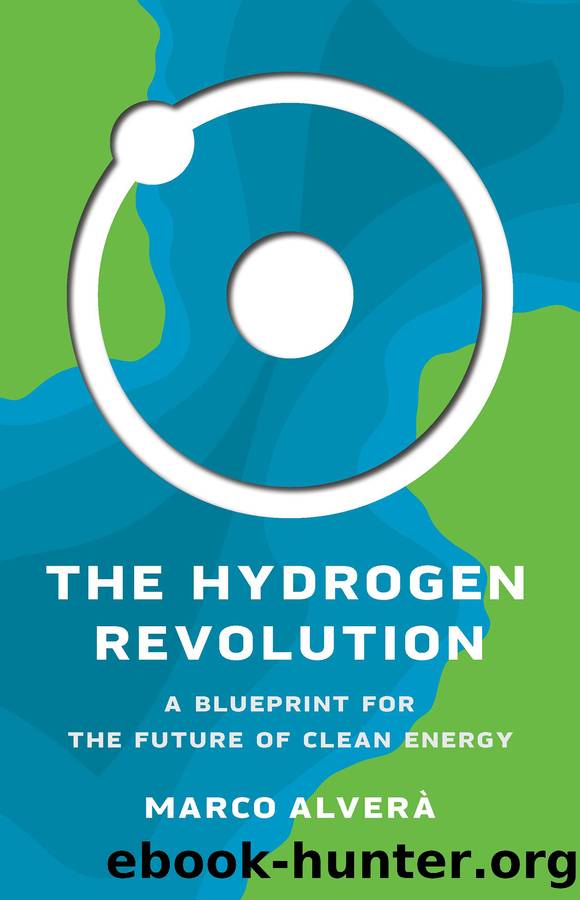The Hydrogen Revolution by Marco Alverà

Author:Marco Alverà [Alverà, Marco]
Language: eng
Format: epub
Published: 2021-11-16T00:00:00+00:00
Total estimated CO2 emissions in industrial sectors, 2019
Green steel
âWhenever I hear an idea for what we can do to keep global warming in check â whether itâs over a conference table or over a cheeseburger â I always ask this question: whatâs your plan for steel?â1
Bill Gates
Steel is at the top of the agenda. It is crucial to our lives â in buildings, bridges and cars, and lots more besides. And it is very dirty.
To make steel from iron ore, you first have to extract the iron. Iron atoms are bound up with oxygen in the ore, and separating them requires a reducing agent: a chemical that will grab the oxygen away from the iron. In a blast furnace, iron ore is heated to about 2,000°C and reduced by burning coke (a fuel made from coal). The coke generates carbon monoxide, which acts as the reducing agent, producing a brittle carbon-rich metal known as pig iron. The exhaust from this process, called works-arising gases, or âWAGâ, is an unlovely soup, rich in carbon dioxide and toxic carbon monoxide. It finds all kinds of uses on site, and you often find it being piped over to neighbouring concerns, who use it for power generation and methanol production; but the upshot is a lot of CO2 venting into the atmosphere. Blowing oxygen through molten pig iron takes out some of the carbon and turns it into steel â releasing a bit more CO2 in the process.
Each year we use more steel: nearly 1,900 million tonnes for the year 2019, which was up by nearly 3.5% from 2018. Every tonne of steel emits about 1.85 tonnes of carbon dioxide on average, so that adds up to 3.5 gigatonnes of CO2, or about 9% of global emissions.2 By 2050, as cities rise and expand across the world, demand is projected to grow by up to 40%.
Scrap steel can be recycled in an electric arc furnace, where an electric current melts it. Steel is about the only construction material that we can recycle indefinitely, and it wonât lose its mechanical properties. As a consequence, an estimated 85% of stainless steel is recycled once it reaches the end of its life â an excellent example of a circular economy â and a well-developed market has grown up around the scrap trade. The electricity can come from renewable resources, which would make this process very clean.
But recycling is limited by the amount of scrap thatâs available, so we need to find a new, sustainable, way to make iron and steel from ore. There are some new ideas in the works to do it directly through electrolysis â melting iron ore and passing a current through so that the oxygen bubbles to the surface â but these are still not widespread technologies.
A much more promising approach is direct reduced iron (DRI), sometimes called sponge iron. In this process, ore is heated to between 800°C to 1,200°C, below the melting point of iron, and a reducing gas is pumped though.
Download
This site does not store any files on its server. We only index and link to content provided by other sites. Please contact the content providers to delete copyright contents if any and email us, we'll remove relevant links or contents immediately.
Zero to IPO: Over $1 Trillion of Actionable Advice from the World's Most Successful Entrepreneurs by Frederic Kerrest(4069)
Machine Learning at Scale with H2O by Gregory Keys | David Whiting(3647)
Harry Potter and the Goblet Of Fire by J.K. Rowling(3612)
Never by Ken Follett(3537)
Ogilvy on Advertising by David Ogilvy(3345)
Shadow of Night by Deborah Harkness(3178)
The Man Who Died Twice by Richard Osman(2812)
Book of Life by Deborah Harkness(2723)
My Brilliant Friend by Elena Ferrante(2705)
How Proust Can Change Your Life by Alain De Botton(2617)
0041152001443424520 .pdf by Unknown(2603)
Will by Will Smith(2582)
The Tipping Point by Malcolm Gladwell(2563)
How to Pay Zero Taxes, 2018 by Jeff A. Schnepper(2503)
Purple Hibiscus by Chimamanda Ngozi Adichie(2496)
Hooked: A Dark, Contemporary Romance (Never After Series) by Emily McIntire(2424)
Rationality by Steven Pinker(2151)
Borders by unknow(2119)
Daughter of Smoke and Bone by Laini Taylor(2083)
